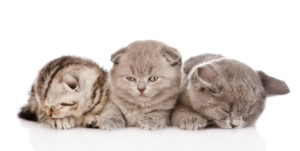Kitten growth and development
A healthy life starts with a healthy diet. Learn more about the growth and development of your kitten here!
Optimal growth and development in kittens
A healthy life starts with a healthy diet. During the kitten stage, the growth and formation of new tissue is at its peak. That’s why proper nutrition is so critical at this stage.
As soon as a cat is born, it starts going through the different stages of development. There are 7 developmental stages:
1. Neonatal Stage (0-14 days)
Kittens are born blind and deaf. They can already feel and smell, and that is how they find their mothers to nurse. At this stage, all they can do is eat and sleep. It’s important in this early stage for kittens to become accustomed to the presence and scent of humans. Their sense of smell is so keen that they will hiss at new smells. On day 8, their eyes open, and on day 9, their ear canals open. It will take a couple more days before the kittens can see very well.
2. Transitional Stage (2-3 weeks)
The kitten is growing more and more aware of its environment. It can now see and hear a bit. It takes its first steps and tries playing with its brothers and sisters. Its baby teeth also start coming in.
3. Primary Socialization Stage (3-7 weeks)
Socialization is underway. The kittens can now see and hear well. They receive plenty of stimulation from their nest, from their humans and perhaps also from other animals. They learn to deal with these stimuli without fear. This is important for handling novel situations later on. They learn to deal with strange noises, to groom themselves, and, by playing with their brothers and sisters, they learn not to bite or scratch too hard. You can give your kitten SANIMED Kitten food starting from 4 weeks of age.
4. Secondary Socialization Stage (7-16 weeks)
At this stage, it’s time for the kitten to go live with its new owner. Socialization continues in its new home. In this stage, it’s important to play with your kitten a lot and to give it plenty of attention. This builds a strong bond of trust.
5. Juvenile Stage (16 weeks – 6 months)
Your kitten is bursting with curiosity and wants to explore everything. You can gradually get them accustomed to going outdoors. Start by going out together briefly using a harness or leash. Your kitten can become disoriented, so it’s best to go slowly at first. After castration or sterilization, your cat can go out without any problems. It is a good idea to have your cat chipped, so in case he gets lost, his address is easily found. During this stage, your cat looses its baby teeth and gets a new set.
6. Puberty (6 months – 1 year)
Puberty starts during this stage. This process is not the same for all cats. It differs by breed and gender.
Females: Females cats go into heat during puberty. This may last a few days to several weeks. The cat will become somewhat restless and affectionate, she will meow a lot and will want to be scratched. It is best to keep unsterilized females indoors, since at this time the risk of an unplanned litter is high.
Toms: A male cat, or “tom”, will exhibit different behavior during puberty. Uncastrated toms should be kept indoors. Until they are castrated, their hormones cause an increased risk of fighting with other tom cats. They may also stray too far from home in search of females in heat.
Once your cat is sterilized or castrated, you may switch to SANIMED Adult cat food.
7. Adulthood (starting from 12-15 months)
Once a kitten is (more or less) full-grown, it becomes a real cat! Most kittens reach adulthood at the age of 12 months. Larger breeds reach maturity at 15 months. This is the moment to switch to adult food, SANIMED Adult cat food.


